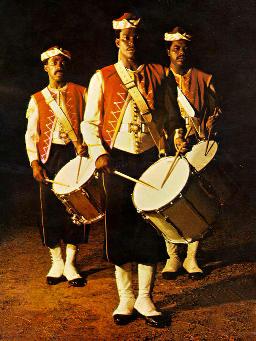
|
|||||||
| Home > Organization > Overview > Music | |||||||
|
|
The affinity between music and the military dates back many centuries, indeed more than two thousand years ago a particular type of Greek heavy infantry traditionally advanced into battle to the music of flutes. Once the loosely coordinated groups of fighters of ancient times became more organised, first into disciplined bands and then proper armies, there soon developed a need for a better means of signalling commands in battle than merely the shouted words of the commanders. The obvious, indeed only answer at the time was the loudest and most portable musical instruments of the day. Early trumpets and especially drums naturally enough, came first, and also had the advantage of transmitting commands by simple code not familiar, at least initially, to the enemy. Coordinated marching also developed, both as a means of driving fear into the enemy by a show of highly disciplined advance into battle and also to better ensure timely and disciplined cross country movement of foot soldiers. An obvious corollary was then to keep time by beat of drum. A simple tune helped even more, and so the fife or its earlier counterpart was added to make the march more lively. Field Marshal the Viscount Montgomery of Alamein, in his ‘History of Warfare’, pointed out that in historical terms the Swiss armies of the late Middle Ages were the first modem soldiers to march in step to music. And so was born the Corps of Drums or ‘the Drums’ as it is colloquially known. Even today, when on parade with the Regimental Band, much more than the Bandmaster, ‘it is the Drum Major carrying his staff at the head of the. parade and wearing his drum belt embroidered with the badge and battle honours, who embodies the regiment’s spirit and history more than any other man present’, as was elegantly expressed in Arthur Taylor’s publication ‘Discovering Military Traditions’. The bugle arrived with the introduction of fight infantry, whose style and speed of movement could not accept the then standard musical instrument, the encumbering drum, for giving orders and signals. What of the military band itself with the wealth of music, especially marches, that have been written for it? In the British and Commonwealth tradition, until the mid-eighteenth century infantry regiment bands comprised hired civilian musicians whose wages were paid by the officers and who frequently were foreigners with unsatisfactory discipline and attitudes. From 1749 however, enlisted soldiers became the bandsmen. At that time the ancient fife, which had long gone out of favour, was re-introduced and in due course the drum and fife band became a norm. Other instruments in the early days of the true military band
were one similar to today’s oboe, and in some regiments the French horn, the clarinet and
the bassoon – and of course the ubiquitous drum. These early bands had a very small
complement, often only six or eight men headed by a drum major – all a far cry from
today’s full regimental band with up to thirty-five bandsmen and its wide range of brass
and wind instruments. |
||||||
|
|
|||||||
